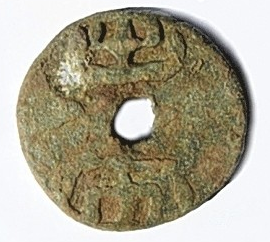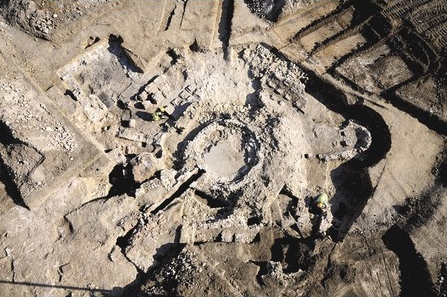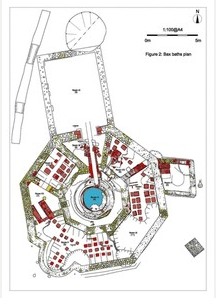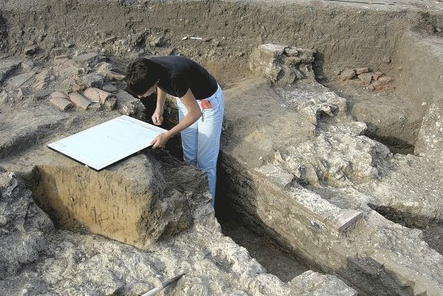Paul Wilkinson
Source - http://www.thisiskent.co.uk/Dr-Paul-Wilkinson-PhD-MIfASWAT-Archaeology/story-19982545-detail/story.html#ixzz2iwTgScDC
Some years ago we were field-walking as part of an archaeological survey just to the west of Faversham in a remote field on what had once been an island overlooking the Swale Estuary.
The field was littered with the remains of a Roman building, but in one area the Roman building material was dense and mixed with very fine decorated Roman pottery.

Bax coin (seal) with the five branched menorah
We returned to the field many years later and proceeded to excavate the structure which, as it was revealed, left us all puzzled. Then suddenly it came to me – it was an octagonal building, and I knew instantly that it was very special indeed. No other Roman building of this type had been found in south-east Britain and there was only two known from the rest of Roman Britain. I also knew what the function of this building was – it was a Christian baptistery from the time when the Roman Empire changed its state religion from the old pagan gods to Christianity.

An aerial photo of archaeological excavations at the Roman baptistery
Weeks later we had uncovered the most exciting Roman building ever to be found in Kent. The architecture was so sophisticated, an octagonal ring of stone walls and an inner ring of arcaded stone walls and at each of the of the eight corners a radiating stone buttress to hold up an inner tower, itself with upper windows which would have streamed light down on to the central plunge pool fed by its own aqueduct. Attached to the octagon were two furnace rooms and a large changing room or narthex. The rest of the building including the room with an apse was a Roman bath house dating from the time of Constantine, the first Christian Roman Emperor who was proclaimed as such in Britain.

The Baptistery built in Rome by Emperor Constantine
But why an octagon? In Christian symbolism eight represents eternity and rebirth, because the world was created in seven days with life starting on the eighth and Christ rose from the dead on the eighth day. For early Christians eight was the number that symbolised the resurrection of Christ and the formation of the New Covenant.
The octagonal plan survives at the baptistery at Grado (c 450) and at Frejus and Albenga. In some baptisteries the octagonal core expands in niches projecting outwards as at Nocera, or surrounded by ambulatory rooms, square at Aquileia (c 450), Riva San Vitale (c 500) and octagonal in the Baptistery of the Arians at Ravenna (c 480).

plan of excavated building.
I knew the history of these buildings and on the last day of excavation I sat on the edge of the plunge pool pondering and sweeping the dust with my hand when I uncovered a large coin, I picked it up and blew the dust away and as I did I saw the engraving of a Jewish Menorah appear, I heard a sound and looked up and there was a man smiling at me and holding out his right hand. He said: "Thank goodness, we were looking for that."
I looked around and my world had been transformed – the walls were up, a blinding light from the windows in the tower was streaming on to the plunge pool making it dance and sparklet. All around me I could hear the sound of cascading water and music, and it was so hot. I looked back at the man and asked why did he need the coin? Attalus explained that today was the baptism of his first born son into the Jewish faith and the tradition was to buy back the child from the priests with five coins engraved with a five-branched Menorah "and I only have four coins, but come let me show you around". We walked through the bath house admiring the decoration and Attalus explained that for most of the time the building functioned as a bath house but once a month on a Sunday Christians used it to baptise new followers. We got to the main entrance and Attalus unlocked the main door. We said our goodbyes. I looked out the door towards the Swale and turned round to find the building once again a ruin. I looked down and lying there was the key to the door, I picked it up and walked to join the rest of my companions.
The full archaeological report of Bax Farm can be found on http://www.kafs.co.uk/

A student recording the aqueduct